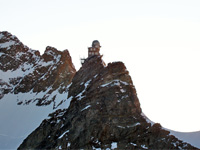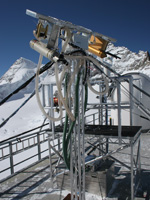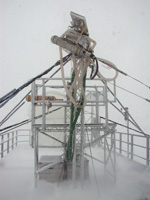Ice Characterisation Experiments
At temperatures below 0C clouds may consist of ice crystals, water droplets, or a mixture of the two, with the phase of cloud particles depending on temperature, but also how the cloud formed and its history. The shape (or habit) of ice crystals present is also an indication of the conditions experienced since formation, as different habits have been shown to grow at different temperatures and supersaturations. Ice and mixed phase clouds are much less well understood than warm clouds, but play and equally important role in the earth’s climate. It is particularly important to understand what effects aerosol have on ice clouds, and current understanding of this is much less advanced than for warm clouds. Ice particles in clouds may be formed by a number of processes, for example homogeneous freezing, immersion nucleation, contact nucleation, and various ice multiplication processes. Much research is ongoing into the role of aerosol in these processes, and which types of aerosol will act as ice nuclei and their efficiency in doing so. Different habits and size distributions of ice particles in cloud are very important in determining its radiative properties. For ice clouds to be correctly represented in global climate models, how their properties depend on changes in aerosol properties must be fully understood.
Ground based experiments at high altitude mountain top sites play an important part in ice cloud studies. During these experiments a suite of cloud instruments are deployed to measure both liquid drops and ice crystals. It is particularly important to distinguish between the two, but at small sizes this is rather difficult to accomplish. Measurements are made of droplet size distribution, liquid water content, and ice crystal images are recorded. These images are analysed to obtain ice particle concentration as a function of size and particle habit, and also ice water content. Additionally various methods are used to collect ice crystals for analysis with techniques such as optical and electron microscopy. Aerosol present at the site are sampled through multiple inlets in a similar way to single site experiments in warm cloud. In some experiments a special version of the counterflow virtual impactor is used, which is able to select and evaporate only ice crystals, so that aerosol particles present within these crystals can be studied.
The Centre for Atmospheric Science has participated in a number of experiments of this type at the Jungfraujoch High Alpine Research Station in the Swiss Alps. Here during early spring temperatures typically range from -25 to -5C and the site experiences a range of clean and relatively polluted conditions as well as occasional desert dust events. Most importantly this site is in cloud for a significant fraction of the time. This makes it an excellent location for such studies under a range of mixed phase and fully glaciated conditions. Additionally there is good access to the site, and suitable infrastructure to allow experiments to take place. Further information about the CLACE projects carried out at this site can be found here.


